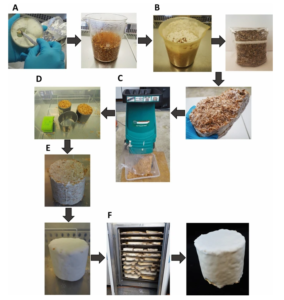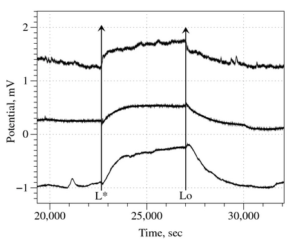
Today, I’d like to discuss the Article Collection “Connecting materials science with fungal biology“ which comprised twelve papers published in Fungal Biology and Biotechnology between Spring 2021 and Spring 2022 (http://www.biomedcentral.com/collections/CMSFB). These papers describe different use cases for fungal mycelium in material science. The applications vary from composite material in construction or for indoor insulation purposes to new materials in the textile and health care industries, as well as others.
I would like to chat with you about some of the contributions described, focusing particularly on practical implications, relevance to current and long-term solutions, and a personal perspective.
1.1 Fungal biocomposites: How to
It has been shown very often that fungal mycelium could be used for the fabrication of bio-composites. These materials consist mainly of lignocellulosic feedstocks that are “glued” together with mycelium. The fungus not only connects the particles but also degrades them, since fungi are the only known living organism that are able to degrade ligno-cellulose. The production process is quite straight forward, starting with pure cultures from petri dishes, followed by pre-culturing in vessels or beakers with a proper substrate, such as grain. The preculture is then used to inoculate larger bags and after that filled in molds to get structured bio-composites. It is well illustrated in the study by Pohl et al. (https://fungalbiolbiotech.biomedcentral.com/articles/10.1186/s40694-022-00133-y) for the fungus Fomes fomentarius and it can be also seen in the following workflow:

1.2 Fungal biocomposites: Practical implications
Conventional composites can be found in many areas of our life. They are generally defined as combinations of different materials, together having specific physical and chemical properties. We are surrounded by composite materials, such as in construction sides, by wood composites or polymers. Some are hidden and used for insulation, or for other purposes. All these materials could be potentially substituted by mycelium based composites. Especially in packaging and insulation production they seem to be promising, and cleaner candidates compared to oil based products.
1.3 Fungal biocomposites: Personal thoughts
I really love the idea of living in a house which consists completely of fungi. The building industry could become more sustainable by using basic principles of circular economy, with fungal mycelium as the stabilizing compound. This fact is covered by a review of Almpani-Lekka et al. with various examples (https://fungalbiolbiotech.biomedcentral.com/articles/10.1186/s40694-021-00124-5). However, personally, I think establishing the new methods will take time and work only to a limited extent. There will be more research needed to also extend the production capacity at larger scales on one hand and to improve the materials properties, for example making them water resistant, on the other hand. A recently published work by Esacker et al. (https://www.mdpi.com/2313-7673/7/2/57) discusses an improvement by adding inorganic clay particles. Nevertheless, the conventional and unsustainable building industry is growing very fast and a rethinking in the sense of using biodegradable material is crucial.
2.1 Intelligent fungal skins: How to
Adamatzky et al. (https://fungalbiolbiotech.biomedcentral.com/articles/10.1186/s40694-021-00113-8) have introduced a relatively new field into the mycelium materials issue by studying if and how living mycelium skins can be used for different purposes. Basically, the production processes remain the same with the difference, that these materials are used as flexible skin sheets with the possibility to react to mechanical or other stimulations. The authors measured electrical activity of the mycelium of Ganoderma resinaceum after stimulating it with weight and light. The outcome is that it reacts to the stimuli by changing the internal, electric potential that was measured.

2.2 Intelligent fungal skins: Practical implication
Due to relatively low production costs and the biology of fungi potentially degrading waste materials, the stimulation response of intelligent living skins could be used in many fields. Flexible and living electronics are also a growing market, since they potentially could substitute rare earths and metals for some applications, where devices are needed to be small and handy.
2.3 Intelligent fungal skins: Personal thoughts
Personally, I think that if fungal intelligent skins are manageable in the future, they could be used for body modification and communication along small distances in or at the human body. One question that spontaneously came into my mind was, whether it is possible to use these skins to help paraplegic people by connecting damaged neurons?
3.1 Risk assessment: How to
As described before, it is imaginable to live in fungal houses and be surrounded by fungal mycelium all the time or to wear fungal skins. However, due to close contact to these partially living materials, a proper risk assessment is needed. Van den Brandhof et al. (https://fungalbiolbiotech.biomedcentral.com/articles/10.1186/s40694-022-00134-x) describes that the selection of the species used should be based on a risk assessment of the mushroom. It must be differentiated between a fungus that is alive and kept alive, for instance for the active production of new material bio-composites and materials that are inactivated or killed as a final step of their production life cycle. Van den Brandhof also classifies the potential risks into different groups, such as the mycotoxin production, their impact on the biotic environment and the pathogenicity of the used fungi.
3.2 Risk assessment: Practical implication
Generally, the materials and the mushrooms are considered to be safe to human beings. This is assumed especially when some of the organisms have been used by humanity for thousands of years or when their usage is described in traditional medicine of human cultures, like in traditional Chinese medicine.

3.3 Risk assessment: Personal thoughts
The recommendations that are given at the end of the described paper are generally a good guide to decide which fungus can be used under which circumstances. However, their approach is, I think, only scratching at the surface and a proper risk assessment should be performed. Killing and inactivating the fungus is useful but only does so much. One should also measure other factors, such as the release of nano-scale particles of the vegetative mycelium that might enters the air and be taken up by breathing. Another factor, which comes from my professional interest and work, are the volatile compounds, that most organisms produce. It is well known that these can be irritating or sometimes toxic. The use of proper in vitro systems for these compounds has been described recently (https://www.mdpi.com/2309-608X/8/1/75). It would also be urgently needed to gain data regarding the safety of the new materials within an occupational context.
All in all, the works discussed here, and the Article Collection in general, are meant to stimulate thought, participation, and engagement. There is still a lot to do, as described in the Article Collection, and the involvement of many disciplines is very important in the process.
Kustrim Cerimi
Latest posts by Kustrim Cerimi (see all)
- Connecting materials science with fungal biology: A personal insight - 15th June 2022
- Fungal pigments from the perspective of a scientist with passion for tattoos - 25th April 2022
- Fungal metabolites in pre- and postnatal human nutrition: How they may affect us and what to do about it - 25th March 2022
Comments